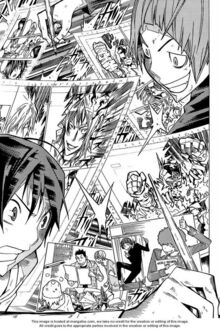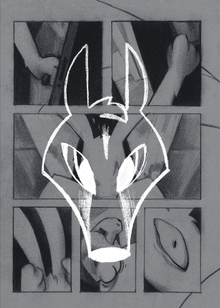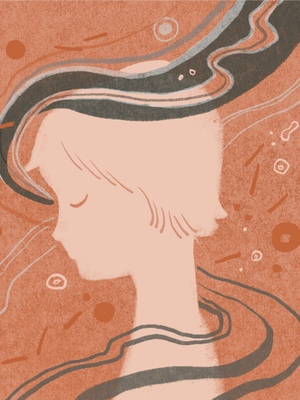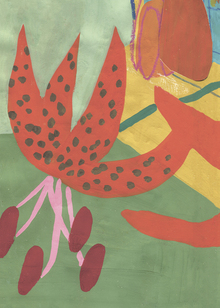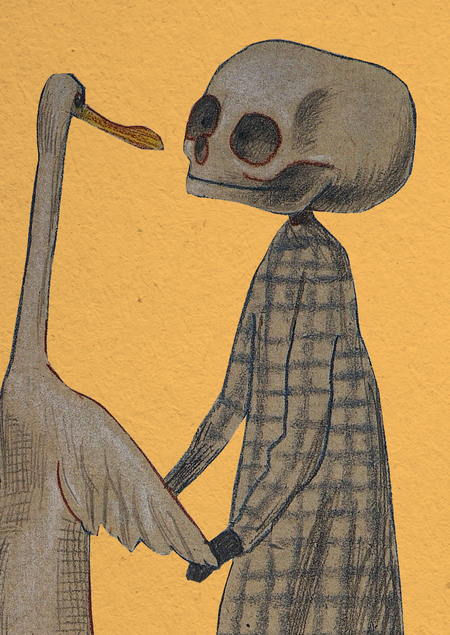
Visual literature. Speaking patterns and trails
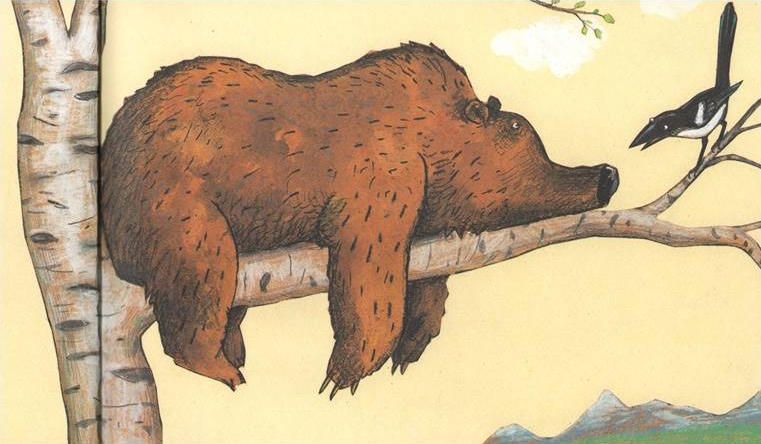
Wolf Earlbrooke. «Median Miracle.»
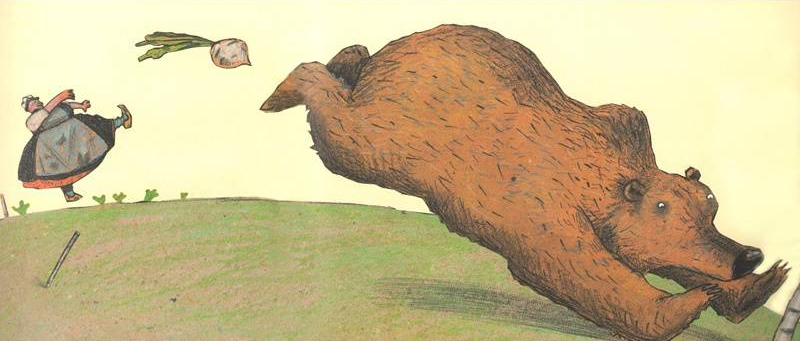
Wolf Earlbrooke. «Median Miracle.»
In the last 50 years, the most active part of the sevenosphere appears to be a variety of visual arts. It is they who extend their influence to the rest of the system and even take over the functions of others (such as the narrative function of the text). The result of this influence is the emergence of new forms of art, the language of which has not been developed and the boundaries have not been defined. This is primarily about visual literature.
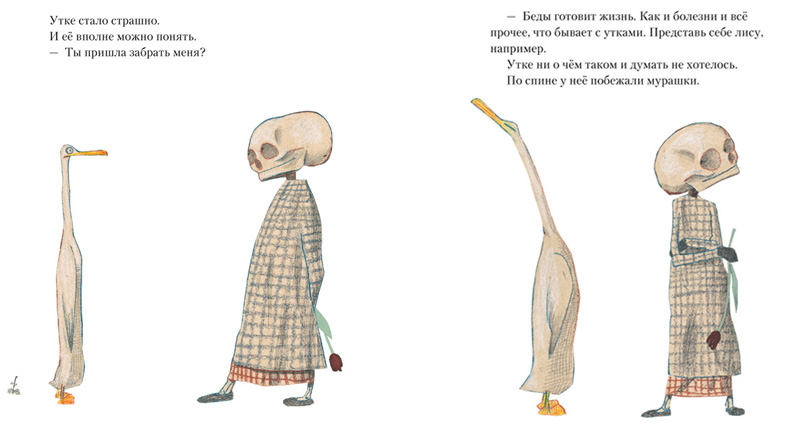
Wolf Earlbrooke. «Duck, death and tulip.»
By visual literature, I mean the whole spectrum of artistic literary works, built on a combination of two levels of communication: visual and verbal, which affect the reader at the same time and, most importantly, are interrelated. Based on this definition, visual literature can include poetic and prosaic artbook, map books, serial genres (such as comics, manga, graphic novel) and numerous, only emerging genres such as a fusion book, visual poetry, etc.
Wolf Earlbrooke. «Duck, death and tulip.»
A children ' s map book, a graphic novel or visual poetry, although originating from various forms of art, merges into a new single species, which therefore requires a different tool to examine the text and images in a comprehensive manner. In the words of the author, the text of the visual literature, the text above-text. If Zlydane assumes the possibility of moving the rhetorical discourse and searching for the visual trails, then in our case it may be a top-trop that arises at the intersection of the visual and textual and impossible without the interaction of these two «traditional» paths. The ways and characteristics of such a troupe are of interest to me in this article. In the case of books of many different styles and directions, I will try to look at the most common above-trops.
«The Tunnel». Anthony Browne.
As a first example, consider the work of British writer Anthony Brown. It is characterized by a realistic image of objects, while the image itself can often be quite fantastic. Brown’s texts are simple and concise, while the image can be full of symbols and allusions. In his book «Tunnel», the author shows how reflexia, being a rather unpleasant and even frightening process, can have a therapeutic effect. The metaphor «forests as the inner world of a child» is represented in Brown’s text in literally two words: a girl enters the forest and the forest begins to scare her. The asceticness of the text is complemented by the richness of the visual series by which the author develops his character by believing to the reader exactly what fears they, the character, are driving. But, on the other hand, the author is not content with the metaphor in the text, which is repeated in the picture. We see here and allusions to classic fairy tales, and to our own works, we see Brown playing famous sayings, and how he conveys the primal or, say, folk base of childhood fears. And he’s doing all this by means of illustrations.
«The Tunnel». Anthony Browne.
Thus, it arises from the fact that the author shares the information between the text and the image. The difficulty of having a relationship with a brother, the reasons why a girl goes into this dark forest of self-awareness, the reader learns from the text, while the details of this metaphorical journey give an image.
«The Tunnel». Anthony Browne.
Peter Cece. «three gold keys.»
Peter Cece. «three gold keys.»
Cece’s own story of the legends of Brunzwig, Golem and Ganucha, which, by the way, is also one of his favorite tricks: we also meet him in the books of «the wall: how I grew behind the iron curtain», «Tibeth: the secret of the red locker», etc. So the visual and textual trails of Sis duplicate each other, creating a top-top, multiple-strengthed, concentrated. There are examples, however, where individually the text and image do not turn to expressive means at all, and the trail only arises at the intersection, reinforcing the relationship between the drawing and the words. This is most often the irony that arises either at a counterpoint or in a situation where the image fills the gaps left in the text.
Peter Cece. «three gold keys.»
An example of the irony of the first type is Wolf Earlbrooke’s book «Night». It’s a relatively early work, just a fourth copyright project. But for Earlbroch, who uses irony in virtually every book, «Night» is very good. In a technical collage, a hilarious book touches on satisfied, serious themes: understanding between adults and children, features of children’s optics and perceptions, even the incomprehensibleness of the world around them.
Peter Cece. «Tibeth: the secret of the red box.»
Peter Cece. «Tibeth: the secret of the red box.»
Thus, the comic effect is achieved by contrasting the father ' s message of peace with the real situation on the night streets.
Peter Cece. «The wall: how I grew up behind the iron curtain.»
Peter Cece. «The wall: how I grew up behind the iron curtain.»
Speaking of trails in children’s literature, it is also worth noting that many of them here, as in folklore, or, say, in fantastic genres, can have a dual nature. In one case, these paths will behave in the same way as, say, in adult poetry, that is, they will be aimed at expressing emotions and giving the text additional meanings. The trails of the second type are not themselves separate paths, because the logic of narrative convinces the reader of the «truth» of the readable, and the trails here lose their original function. In children’s literature (for example, in almost all classic fairy tales) hyperbola, allegory, and representation are the most common paths. Thus, the enormous growth of the fabulous giant is not necessarily the hyperbole by which the author conveys the greatness of the character, but rather the given (fantastic, of course, but nonetheless). Just like talking animals, it’s not necessarily an allegorical image of people. Of course, we are interested in the first type of trail in this work, as it is they who are involved in the creation of visual literature.
Wolf Earlbrooke. «Tonight»
Wolf Earlbrooke. «Tonight»
All the above examples seem to support the hypothesis that there is a common language of the image and text. However, it would be strange to assume that all the properties and functions of the text are moved to the illustration. For example, the possibility of painting in a literal image of an intangible, such as inspiration, conscience, or, for example, a god invisible to one’s side (like, say, Homer’s in «Iliad») is quite limited. It is also difficult to illustrate language games, such as calamaries or sound recordings. There are also special features with the shapes of the speech. Some of them, such as inversion, hiasma, rhetorical exclamation and questions, or oxymoron, are, in principle, insensitive to painting (remember the most common example with a square circle). Another part, like repetition, parallelism, or graduation, is transferred to images with ease, but it doesn’t make sense there.
Emily Gravette. Matilda’s Cat.
Consider, for example, Laurel Long’s book The Twelve Days of Christmas. It’s a Christmas song in which every verse begins with the first (second and so on) Christmas Day real love gave the author a gift. Every next day repeats the gifts of the previous days and adds another. The illustrations are thus synchronous: with each new turn of events, more and more gifts are shown in the paintings. For example, on the seventh day, seven swimming swans became a gift. Six geese, five gold rings, four dredges and all the rest are encrypted in the landscape, in the form of shrubs, coastal stones, etc.
Emily Gravette. Matilda’s Cat.
Emily Gravette. Matilda’s Cat.
Of course, it is not possible to describe all the features of visual literature in a single article. However, even a superficial review of the most common techniques may in the future allow for a different perspective and borderline cases, such as, say, a novel without the text «End» of Sean Tan or stories without David Weissner’s text, and traditional children’s works included this time in a broader context of visual literature (i.e., in one context with a comic book and a graphic novel).
